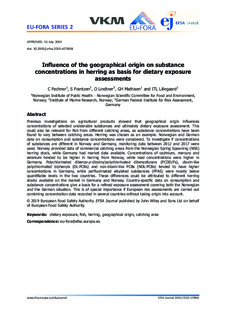| dc.contributor.author | Fechner, C. | |
| dc.contributor.author | Frantzen, Sylvia | |
| dc.contributor.author | Lindtner, O | |
| dc.contributor.author | Mathisen, Gro Haarklou | |
| dc.contributor.author | Lillegaard, Inger Therese L. | |
| dc.date.accessioned | 2020-01-13T12:48:25Z | |
| dc.date.available | 2020-01-13T12:48:25Z | |
| dc.date.created | 2020-01-02T16:48:11Z | |
| dc.date.issued | 2019 | |
| dc.identifier.citation | EFSA Journal. 2019, 17 (S2), . | nb_NO |
| dc.identifier.issn | 1831-4732 | |
| dc.identifier.uri | http://hdl.handle.net/11250/2635987 | |
| dc.description.abstract | Previous investigations on agricultural products showed that geographical origin influences concentrations of selected undesirable substances and ultimately dietary exposure assessment. This could also be relevant for fish from different catching areas, as substance concentrations have been found to vary between catching areas. Herring was chosen as an example. Norwegian and German data on consumption and substance concentrations were considered. To investigate if concentrations of substances are different in Norway and Germany, monitoring data between 2012 and 2017 were used. Norway provided data of commercial catching areas from the Norwegian Spring Spawning (NSS) herring stock, while Germany had market data available. Concentrations of cadmium, mercury and selenium tended to be higher in herring from Norway, while lead concentrations were higher in Germany. Polychlorinated dibenzo‐p‐dioxins/polychlorinated dibenzofurans (PCDD/Fs), dioxin‐like polychlorinated biphenyls (DL‐PCBs) and non‐dioxin‐like PCBs (NDL‐PCBs) tended to have higher concentrations in Germany, while perfluorinated alkylated substances (PFAS) were mostly below quantifiable levels in the two countries. These differences could be attributed to different herring stocks available on the market in Germany and Norway. Country‐specific data on consumption and substance concentrations give a basis for a refined exposure assessment covering both the Norwegian and the German situation. This is of special importance if European risk assessments are carried out combining concentration data recorded in several countries without taking origin into account. | nb_NO |
| dc.language.iso | eng | nb_NO |
| dc.title | Influence of the geographical origin on substance concentrations in herring as basis for dietary exposure assessments | nb_NO |
| dc.type | Journal article | nb_NO |
| dc.type | Peer reviewed | nb_NO |
| dc.description.version | publishedVersion | nb_NO |
| dc.source.pagenumber | 15 | nb_NO |
| dc.source.volume | 17 | nb_NO |
| dc.source.journal | EFSA Journal | nb_NO |
| dc.source.issue | S2 | nb_NO |
| dc.identifier.doi | 10.2903/j.efsa.2019.e170904 | |
| dc.identifier.cristin | 1765464 | |
| cristin.unitcode | 7431,33,0,0 | |
| cristin.unitname | Fremmed- og smittestoff | |
| cristin.ispublished | true | |
| cristin.fulltext | original | |
| cristin.qualitycode | 1 | |
